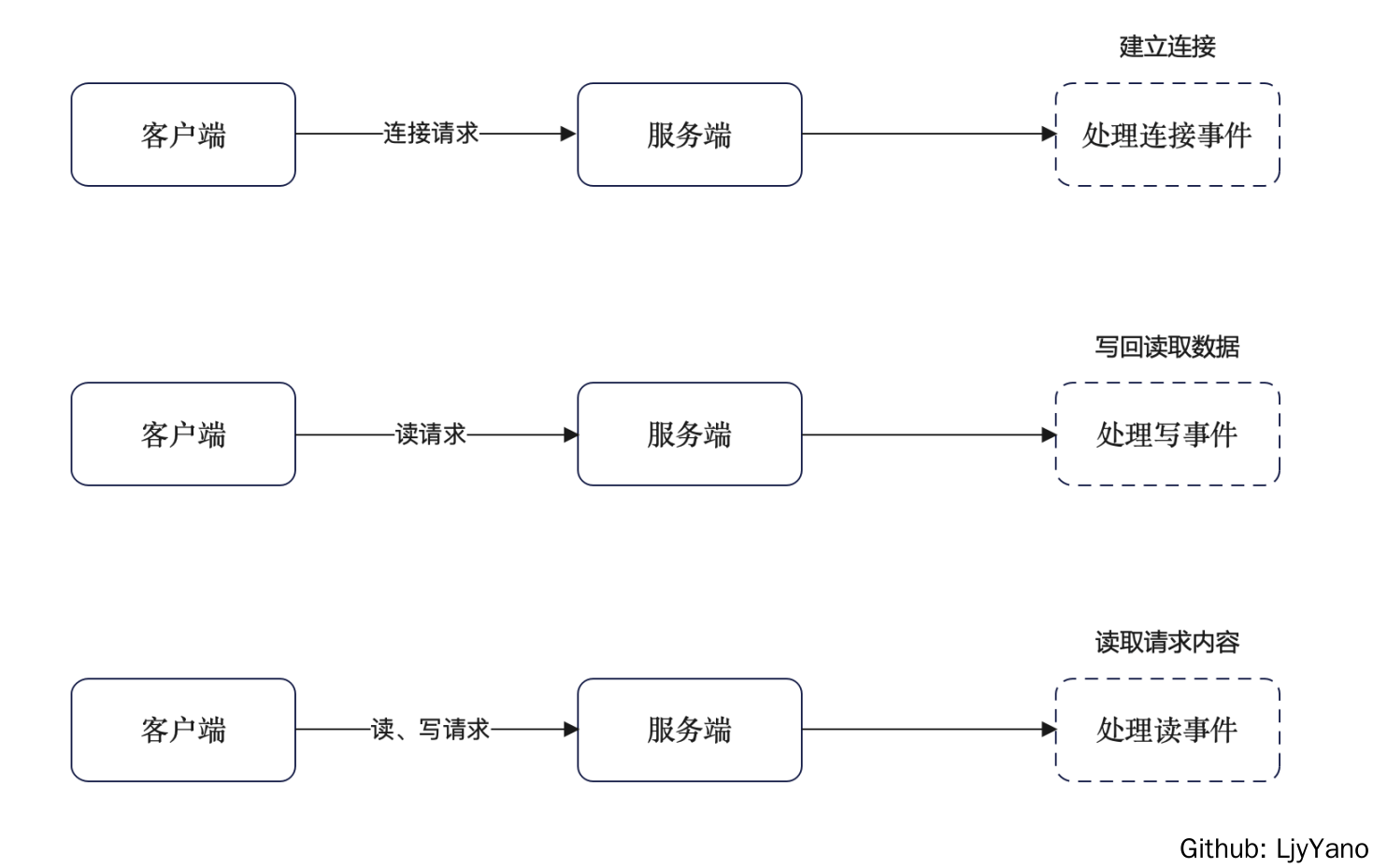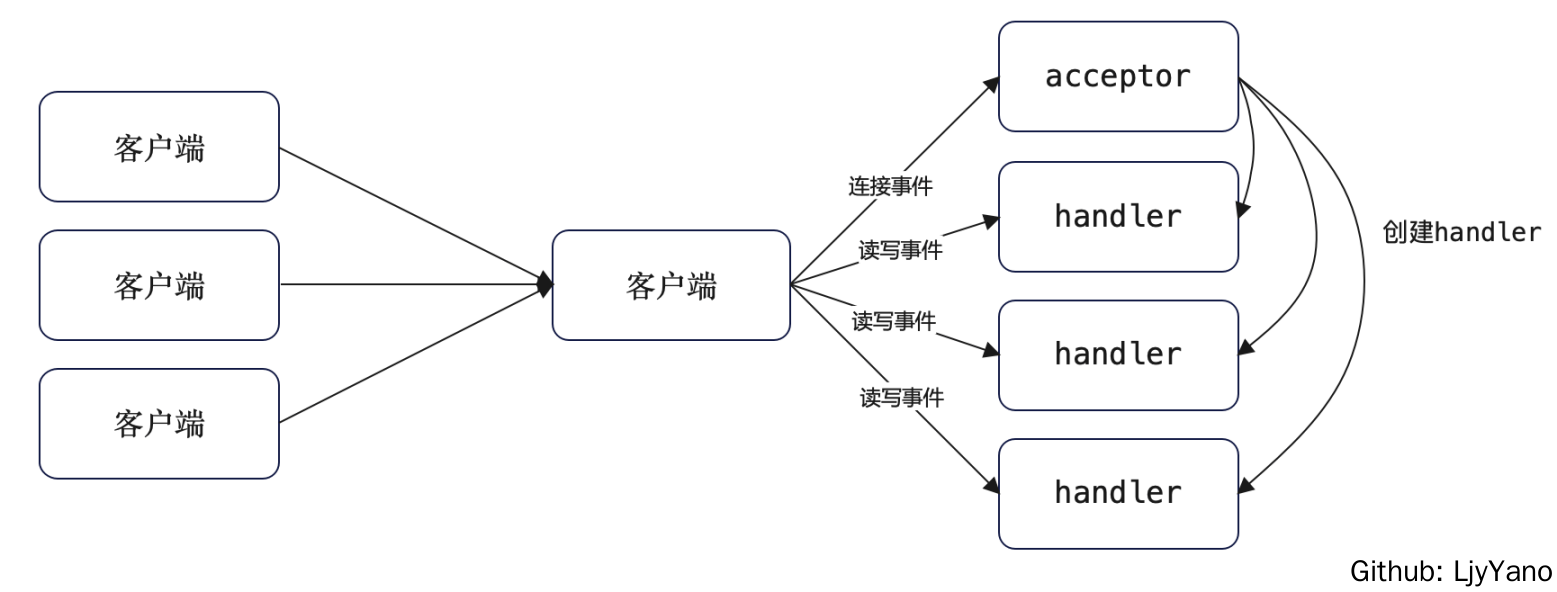Redis 源码简洁剖析8—Reactor 模型原创
Reactor 模型
网络服务器端,用了处理高并发网络 IO请求的一种编程模型。
处理 3 类事件:
- 连接事件:客户端→服务器的连接请求,对应服务端的连接事件
- 写事件:客户端→服务器的读请求,服务端处理后要写回客户端,对应服务端的写事件
- 读事件:服务端要从客户端读取请求内容,对应服务端的读事件
3 个关键角色:
- acceptor:处理连接事件,接收连接、创建 handler
- handler:处理读写事件
- reactor:专门监听和分配事件,连接请求 → acceptor、读写请求 → handler
事件驱动框架
事件驱动框架就是 Reactor 的具体实现。包括:
- 事件初始化:创建要监听的事件类型,及该类事件对应的 handler
- 事件捕获、分发和处理主循环:
- 捕获发生的事件
- 判断事件类型
- 根据事件类型,调用对应 handler 处理事件
Redis 如何实现 Reactor 模型
实现代码:
- 头文件:ae.h
- 实现:ae.c
事件的数据结构:aeFileEvent
Redis 的事件驱动框架定义了 2 类事件:
- IO 事件
- 时间事件
下面介绍 IO 事件 aeFileEvent 的数据结构:
/* File event structure */
typedef struct aeFileEvent {
// 事件类型的掩码,AE_(READABLE|WRITABLE|BARRIER)
int mask;
// AE_READABLE 事件的处理函数
aeFileProc *rfileProc;
// AE_WRITABLE 事件的处理函数
aeFileProc *wfileProc;
// 指向客户端私有数据
void *clientData;
} aeFileEvent;
主循环:aeMain 函数
是在 Redis 初始化时调用的,详见 Redis 源码简洁剖析 07 - main 函数启动。
void aeMain(aeEventLoop *eventLoop) {
eventLoop->stop = 0;
// 循环调用
while (!eventLoop->stop) {
// 核心函数,处理事件的逻辑
aeProcessEvents(eventLoop, AE_ALL_EVENTS|
AE_CALL_BEFORE_SLEEP|
AE_CALL_AFTER_SLEEP);
}
}
代码非常简单,就是循环调用 aeProcessEvents 函数。aeMain 是在 main 函数中被调用的:
// 事件驱动框架,循环处理各种触发的事件
aeMain(server.el);
// 循环结束,删除 eventLoop
aeDeleteEventLoop(server.el);
事件捕获与分发:aeProcessEvents 函数
主体有 3 个 if 分支:
int aeProcessEvents(aeEventLoop *eventLoop, int flags)
{
int processed = 0, numevents;
/* 若没有事件处理,则立刻返回*/
if (!(flags & AE_TIME_EVENTS) && !(flags & AE_FILE_EVENTS)) return 0;
/*如果有 IO 事件发生,或者紧急的时间事件发生,则开始处理*/
if (eventLoop->maxfd != -1 || ((flags & AE_TIME_EVENTS) && !(flags & AE_DONT_WAIT))) {
…
}
/* 检查是否有时间事件,若有,则调用 processTimeEvents 函数处理 */
if (flags & AE_TIME_EVENTS)
processed += processTimeEvents(eventLoop);
/* 返回已经处理的文件或时间*/
return processed;
}
核心是第 2 个 if 语句:
// 有 IO 事件发生 || 紧急时间事件发生
if (eventLoop->maxfd != -1 ||
((flags & AE_TIME_EVENTS) && !(flags & AE_DONT_WAIT))) {
……
// 调用 aeApiPoll 捕获事件
numevents = aeApiPoll(eventLoop, tvp);
……
}
aeApiPoll 函数如何捕获事件?依赖于操作系统底层提供的 IO 多路复用机制,实现事件捕获,检查是否有新的连接、读写事件的发生。为了适配不同的操作系统,Redis 对不同操作系统实现网络 IO 多路复用函数,进行统一封装,封装后的代码在 4 个文件中实现:
- ae_epoll.c,对应 Linux 上的 IO 复用函数 epoll
- ae_evport.c,对应 Solaris 上的 IO 复用函数 evport
- ae_kqueue.c,对应 macOS 或 FreeBSD 上的 IO 复用函数 kqueue
- ae_select.c,对应 Linux(或 Windows)的 IO 复用函数 select
ae_epoll.c 中 aeApiPoll 函数的实现,核心是调用了 epoll_wait 函数,并将 epoll 返回的事件信息保存起来。
static int aeApiPoll(aeEventLoop *eventLoop, struct timeval *tvp) {
aeApiState *state = eventLoop->apidata;
int retval, numevents = 0;
// 调用 epoll_wait 获取监听到的事件
retval = epoll_wait(state->epfd,state->events,eventLoop->setsize,
tvp ? (tvp->tv_sec*1000 + (tvp->tv_usec + 999)/1000) : -1);
if (retval > 0) {
int j;
// 获取监听到的事件数量
numevents = retval;
// 处理每个事件
for (j = 0; j < numevents; j++) {
int mask = 0;
struct epoll_event *e = state->events + j;
if (e->events & EPOLLIN) mask |= AE_READABLE;
if (e->events & EPOLLOUT) mask |= AE_WRITABLE;
if (e->events & EPOLLERR) mask |= AE_WRITABLE | AE_READABLE;
if (e->events & EPOLLHUP) mask |= AE_WRITABLE | AE_READABLE;
// 保存事件信息
eventLoop->fired[j].fd = e->data.fd;
eventLoop->fired[j].mask = mask;
}
}
return numevents;
}
在 Mac 上查看源码,aeApiPoll 方法会进入 ae_kqueue.c 中:
static int aeApiPoll(aeEventLoop *eventLoop, struct timeval *tvp) {
aeApiState *state = eventLoop->apidata;
int retval, numevents = 0;
if (tvp != NULL) {
struct timespec timeout;
timeout.tv_sec = tvp->tv_sec;
timeout.tv_nsec = tvp->tv_usec * 1000;
retval = kevent(state->kqfd, NULL, 0, state->events, eventLoop->setsize,
&timeout);
} else {
retval = kevent(state->kqfd, NULL, 0, state->events, eventLoop->setsize,
NULL);
}
if (retval > 0) {
int j;
/* Normally we execute the read event first and then the write event.
* When the barrier is set, we will do it reverse.
*
* However, under kqueue, read and write events would be separate
* events, which would make it impossible to control the order of
* reads and writes. So we store the event's mask we've got and merge
* the same fd events later. */
for (j = 0; j < retval; j++) {
struct kevent *e = state->events+j;
int fd = e->ident;
int mask = 0;
if (e->filter == EVFILT_READ) mask = AE_READABLE;
else if (e->filter == EVFILT_WRITE) mask = AE_WRITABLE;
addEventMask(state->eventsMask, fd, mask);
}
/* Re-traversal to merge read and write events, and set the fd's mask to
* 0 so that events are not added again when the fd is encountered again. */
numevents = 0;
for (j = 0; j < retval; j++) {
struct kevent *e = state->events+j;
int fd = e->ident;
int mask = getEventMask(state->eventsMask, fd);
if (mask) {
eventLoop->fired[numevents].fd = fd;
eventLoop->fired[numevents].mask = mask;
resetEventMask(state->eventsMask, fd);
numevents++;
}
}
}
return numevents;
}
事件注册:aeCreateFileEvent 函数
main 函数中调用了 createSocketAcceptHandler:
if (createSocketAcceptHandler(&server.ipfd, acceptTcpHandler) != C_OK) {
serverPanic("Unrecoverable error creating TCP socket accept handler.");
}
而 createSocketAcceptHandler 创建接收连接的 handler:
int createSocketAcceptHandler(socketFds *sfd, aeFileProc *accept_handler) {
int j;
for (j = 0; j < sfd->count; j++) {
if (aeCreateFileEvent(server.el, sfd->fd[j], AE_READABLE, accept_handler,NULL) == AE_ERR) {
/* Rollback */
for (j = j-1; j >= 0; j--) aeDeleteFileEvent(server.el, sfd->fd[j], AE_READABLE);
return C_ERR;
}
}
return C_OK;
}
其主要是调用了 aeCreateFileEvent,aeCreateFileEvent 就是实现事件和处理函数注册的核心函数。
int aeCreateFileEvent(aeEventLoop *eventLoop, int fd, int mask,
aeFileProc *proc, void *clientData)
{
// 错误处理
if (fd >= eventLoop->setsize) {
errno = ERANGE;
return AE_ERR;
}
aeFileEvent *fe = &eventLoop->events[fd];
// 核心
if (aeApiAddEvent(eventLoop, fd, mask) == -1)
return AE_ERR;
fe->mask |= mask;
if (mask & AE_READABLE) fe->rfileProc = proc;
if (mask & AE_WRITABLE) fe->wfileProc = proc;
fe->clientData = clientData;
if (fd > eventLoop->maxfd)
eventLoop->maxfd = fd;
return AE_OK;
}
Linux 提供了 epoll_ctl API,用于增加新的观察事件。而 Redis 在此基础上,封装了 aeApiAddEvent 函数,对 epoll_ctl 进行调用,注册希望监听的事件和相应的处理函数。
ae_epoll.c 中 aeApiAddEvent 实现如下:
static int aeApiAddEvent(aeEventLoop *eventLoop, int fd, int mask) {
aeApiState *state = eventLoop->apidata;
struct epoll_event ee = {0};
/* If the fd was already monitored for some event, we need a MOD
* operation. Otherwise we need an ADD operation. */
int op = eventLoop->events[fd].mask == AE_NONE ?
EPOLL_CTL_ADD : EPOLL_CTL_MOD;
ee.events = 0;
mask |= eventLoop->events[fd].mask; /* Merge old events */
if (mask & AE_READABLE) ee.events |= EPOLLIN;
if (mask & AE_WRITABLE) ee.events |= EPOLLOUT;
ee.data.fd = fd;
// 增加新的观察事件
if (epoll_ctl(state->epfd,op,fd,&ee) == -1) return -1;
return 0;
}
注册的函数 acceptTcpHandler 在 network.c 中:
void acceptTcpHandler(aeEventLoop *el, int fd, void *privdata, int mask) {
int cport, cfd, max = MAX_ACCEPTS_PER_CALL;
char cip[NET_IP_STR_LEN];
UNUSED(el);
UNUSED(mask);
UNUSED(privdata);
// 每次处理 1000 个
while(max--) {
cfd = anetTcpAccept(server.neterr, fd, cip, sizeof(cip), &cport);
if (cfd == ANET_ERR) {
if (errno != EWOULDBLOCK)
serverLog(LL_WARNING,
"Accepting client connection: %s", server.neterr);
return;
}
anetCloexec(cfd);
serverLog(LL_VERBOSE,"Accepted %s:%d", cip, cport);
acceptCommonHandler(connCreateAcceptedSocket(cfd),0,cip);
}
}
总结
Redis 处理连接、客户端请求是单线程的,但是这单个线程能够处理上千个客户端,就是因为 Redis 是基于 Reactor 模型的。通过事件驱动框架,Redis 可以使用一个循环不断捕获、分发、处理客户端产生的网络连接、数据读写事件。当然这里有一个前提,就是 Redis 几乎所有数据读取和处理都是在内存中操作的,服务端对单个客户端的读写请求处理时间极短。







